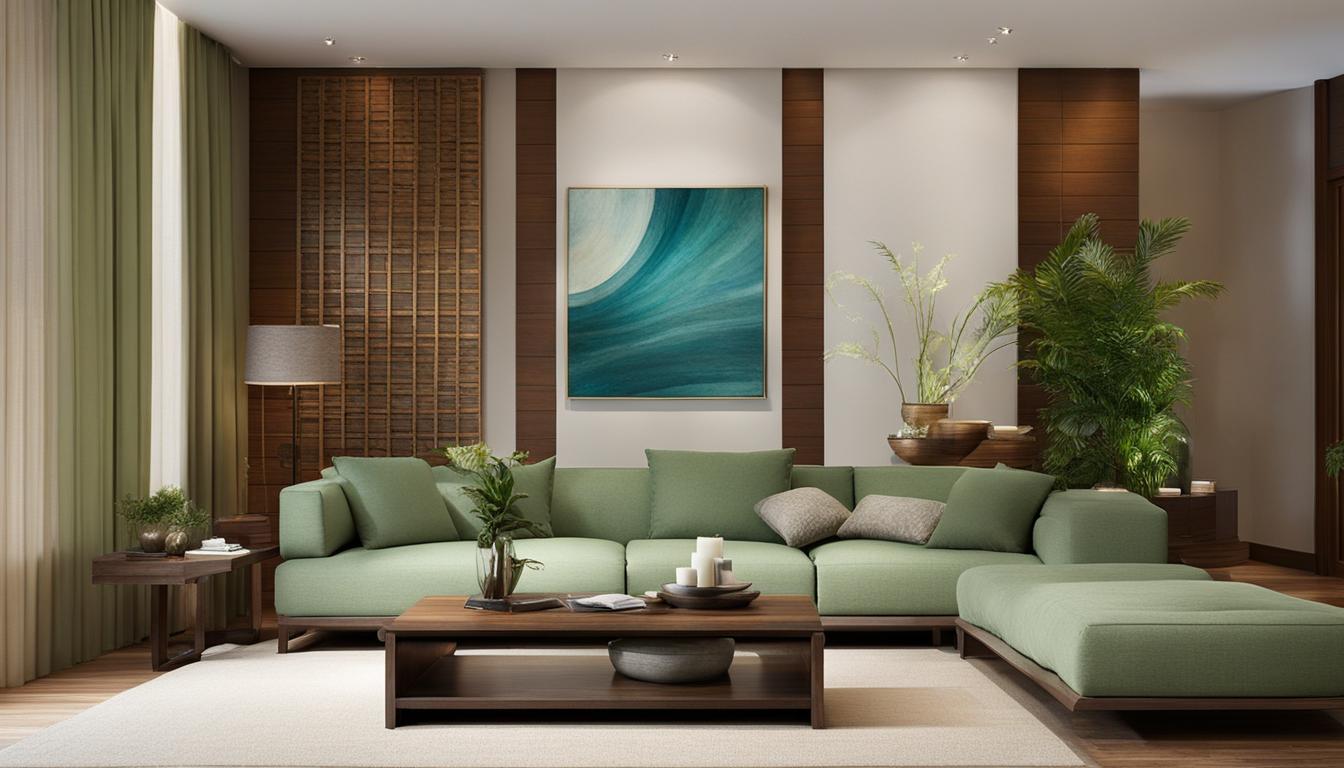Welcome to our guide on selecting the best Feng Shui colors for your living room! Did you know that the colors you choose can greatly influence the energy flow in your space? By following the principles of Feng Shui, you can create a living room that promotes harmony, relaxation, and positive energy.
In this section, we will discuss the importance of choosing the right colors for your living room and how they can enhance your overall well-being. We will explore color psychology, harmonious color schemes, and the influence of natural elements and Yin and Yang energies in Feng Shui. Get ready to transform your living room into a tranquil and harmonious space!
Key Takeaways:
- Choosing the right colors according to Feng Shui principles can enhance harmony and positive energy in your living room.
- Understanding color psychology is crucial in selecting colors that promote relaxation, tranquility, and vitality.
- Harmonizing colors in your living room is essential for creating a balanced and harmonious space.
- The five elements of Feng Shui correspond to specific colors that can enhance different aspects of energy in your living room.
- Proper color placement and incorporating natural elements and Yin and Yang energies can maximize the flow of positive energy in your living room.
Understanding the Basics of Feng Shui
If you’re looking for ways to create positive energy in your home, understanding the principles of Feng Shui is a great place to start. Feng Shui is an ancient Chinese art and science that aims to improve the flow of energy or “qi” in a space. By achieving a balance between the elements of nature and the environment, Feng Shui can create harmony, balance, and positive energy in your home.
At its core, Feng Shui is based on the idea that everything in the universe is connected, and that our physical surroundings have a profound impact on our wellbeing and quality of life. The principles of Feng Shui are grounded in the five elements of nature: Wood, Fire, Earth, Metal, and Water.
The Five Elements of Feng Shui
In Feng Shui, each of the five elements is associated with specific colors and materials that can be used to balance and enhance the flow of energy in a space. Here’s a brief overview of each of the five elements:
| Element | Color | Materials |
|---|---|---|
| Wood | Green, Brown | Wood, Plants |
| Fire | Red, Orange, Yellow, Purple, Pink | Candles, Lighting, Sunlight |
| Earth | Light Yellow, Beige | Clay, Earth, Rock, Stone |
| Metal | White, Gray, Silver, Gold | Metal, Stainless Steel |
| Water | Blue, Black | Water, Aquariums, Mirrors |
Each element also corresponds to different areas of life, such as career, health, wealth, and relationships. By balancing and enhancing these elements in your home, you can create positive energy flow and improve different aspects of your life.
Creating Positive Energy in Your Home
Now that you understand the basics of Feng Shui, it’s time to start applying these principles to your home. Here are some tips for creating positive energy in your living space:
- Avoid clutter: A cluttered space can disrupt the flow of energy and create stress and anxiety. Keep your living space clean and organized.
- Let in natural light: Natural light is a great way to enhance the energy flow in your home. Open curtains and blinds during the day to let in sunlight.
- Include natural elements: Incorporating natural elements like plants and wood can create a peaceful and calming atmosphere.
- Choose appropriate colors: As we discussed earlier, colors play a significant role in Feng Shui. Choose colors that align with the elements and areas of your life that you want to enhance.
- Place furniture strategically: The placement of furniture can impact the flow of energy in a room. Avoid placing furniture in direct paths of movement, such as in front of doors or windows.
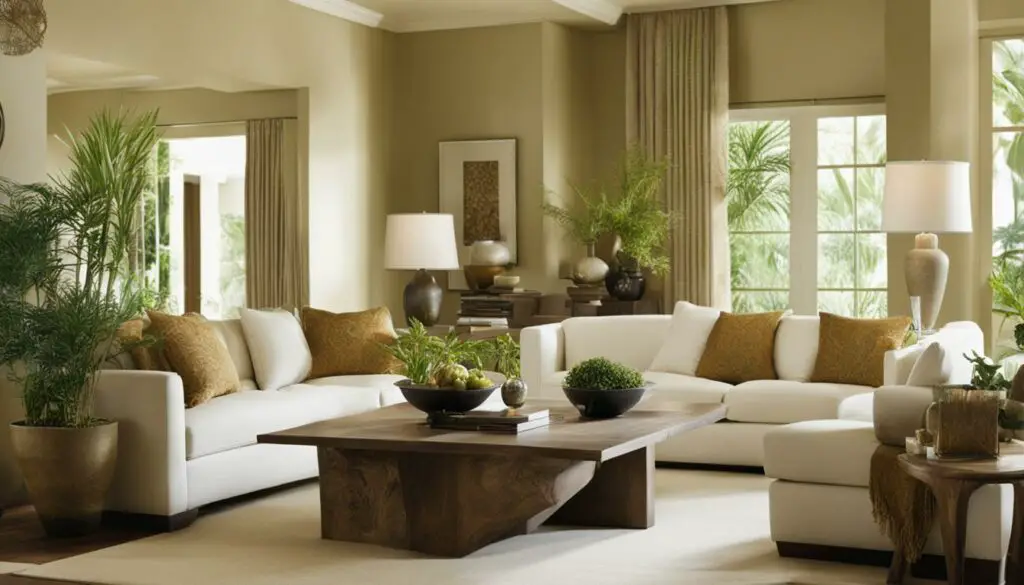
The Power of Color Psychology in Feng Shui
Color has a powerful impact on our emotions and can greatly influence the energy flow in your living room. Understanding color psychology is crucial in selecting the best Feng Shui colors for your space. Each color has its unique characteristics that can promote or inhibit good energy in your home.
“Color is a power which directly influences the soul.” – Wassily Kandinsky
The following table showcases some of the most commonly used colors in Feng Shui and their psychological effects:
| Color | Psychological Effect |
|---|---|
| Red | Stimulating, Passionate, Energetic |
| Orange | Friendly, Creative, Warm |
| Yellow | Cheerful, Optimistic, Happy |
| Green | Harmonizing, Refreshing, Calming |
| Blue | Soothing, Tranquil, Relaxing |
| Purple | Mysterious, Luxurious, Spiritual |
| White | Clean, Pure, Innocent |
| Black | Powerful, Elegant, Sophisticated |
Keep in mind that the shades and tones of each color can also affect the overall energy flow in your living room. For example, a bright red may be too stimulating, while a soft pink can promote a sense of love and harmony. Similarly, a dark green may be too heavy, while a light sage green can create a refreshing and calming atmosphere.
It’s essential to consider your personal preferences and the specific energy you want to enhance in your living room before selecting a color scheme. By incorporating the right colors, you can create a harmonious and inviting space that promotes positive energy and enhances your well-being.
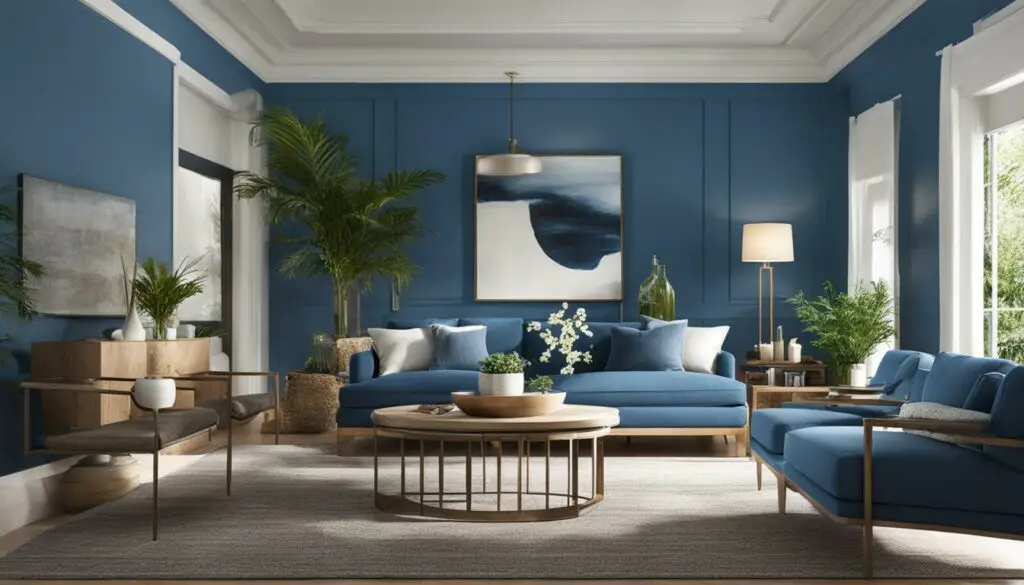
Creating a Harmonious Color Scheme
Harmonizing the colors in your living room is crucial for a balanced and harmonious space. The right color scheme can promote positive energy, enhance the flow of chi, and create a welcoming ambiance. Here are some tips on creating a Feng Shui living room color scheme:
- Start with a neutral base: Begin with a neutral color, such as white, beige, or gray, as the foundation for your living room. Neutral colors promote relaxation and create a calming atmosphere.
- Incorporate a Feng Shui color: Choose a Feng Shui color that aligns with the energy you want to promote in your living room. For example, green represents growth and prosperity, while red symbolizes passion and excitement.
- Use accent colors: Incorporate accent colors that complement the main Feng Shui color in your living room. These can be used in throw pillows, artwork, or accessories. Avoid using too many accent colors, as this can create a chaotic and unbalanced space.
Here is an example of a harmonious Feng Shui living room color scheme:
| Color | Feng Shui Element | Description |
|---|---|---|
| White | Metal | Represents clarity and precision, creates a peaceful and organized atmosphere. |
| Soft Blue | Water | Symbolizes calmness and tranquility, promotes relaxation. |
| Green | Wood | Represents growth and vitality, promotes harmony and balance. |
| Gold | Earth | Symbolizes abundance and prosperity, creates a warm and welcoming atmosphere. |
Remember, the key to a harmonious color scheme is balance and simplicity. Choose colors that promote positive energy and complement each other, and use them purposefully throughout your living room.
The Five Elements in Feng Shui
The five elements of Feng Shui – Wood, Fire, Earth, Metal, and Water – have a significant impact on the energy flow in your living room. Each element has specific colors associated with it that can promote different aspects of energy in your space. Understanding these elements and their corresponding colors is key to choosing the best Feng Shui colors for your home.
| Element | Color | Description |
|---|---|---|
| Wood | Green, Brown | Symbolizes growth, vitality, and new beginnings. Green promotes balance and harmony, while brown adds warmth and stability |
| Fire | Red, Orange, Pink, Purple | Represents passion, creativity, and enthusiasm. Red symbolizes good luck and fortune, while pink and purple bring in a sense of love and romance. |
| Earth | Yellow, Beige | Symbolizes stability and nurturing energy. Yellow promotes clarity and focus, while beige adds a grounding effect. |
| Metal | White, Gray, Metallic hues | Represents clarity, precision, and efficiency. White promotes purity and cleanliness, while gray adds a sense of sophistication and elegance. |
| Water | Blue, Black | Symbolizes calmness, ease, and abundance. Blue promotes relaxation and tranquility, while black adds depth and mystery. |
When selecting the best Feng Shui colors for your living room, consider which elements you want to enhance and balance in your space. You can also incorporate multiple elements and colors to create a harmonious and balanced atmosphere.
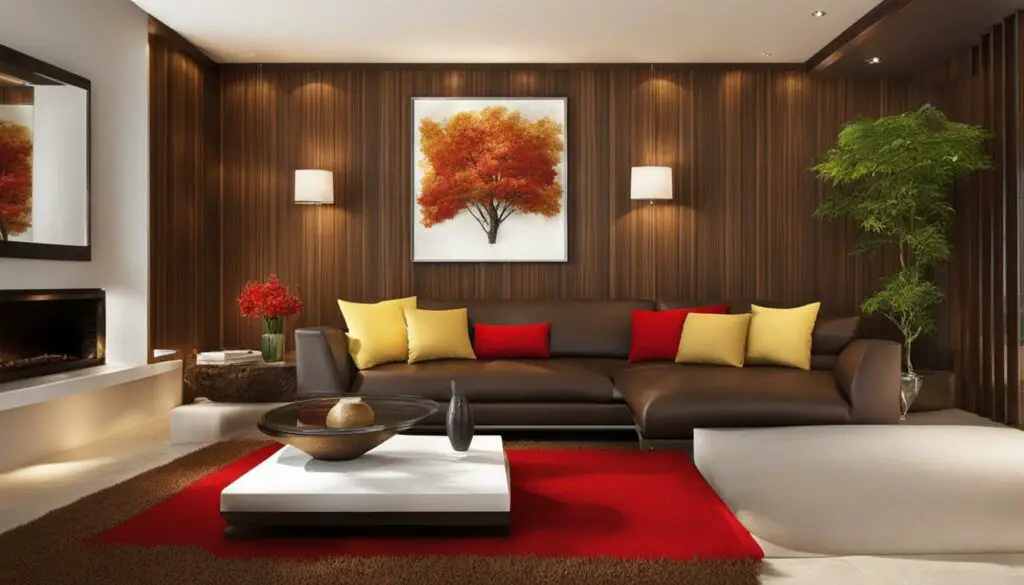
Best Feng Shui Colors for a Calm and Serene Living Room
A serene living room is essential for relaxation and rejuvenation. Choosing the right colors is crucial in creating a peaceful and tranquil atmosphere. Here are some of the best Feng Shui colors for a calm and soothing living room:
| Color | Symbolism |
|---|---|
| Blue | Symbolizes peace and tranquility. Light blue shades can evoke a sense of serenity, while darker blues can promote introspection and calmness. |
| Green | Symbolizes growth, renewal, and harmony. It can promote balance and relaxation in your living room. |
| Gray | Symbolizes neutrality and balance. Gray can create a calming and soothing atmosphere, especially when combined with other soft hues. |
| Beige | Symbolizes simplicity and comfort. Beige can create a warm and inviting atmosphere, perfect for a relaxed living room space. |
Incorporating these colors into your living room can evoke a sense of relaxation and tranquility. You can use them as the main color scheme or accents to create a balanced and harmonious space.
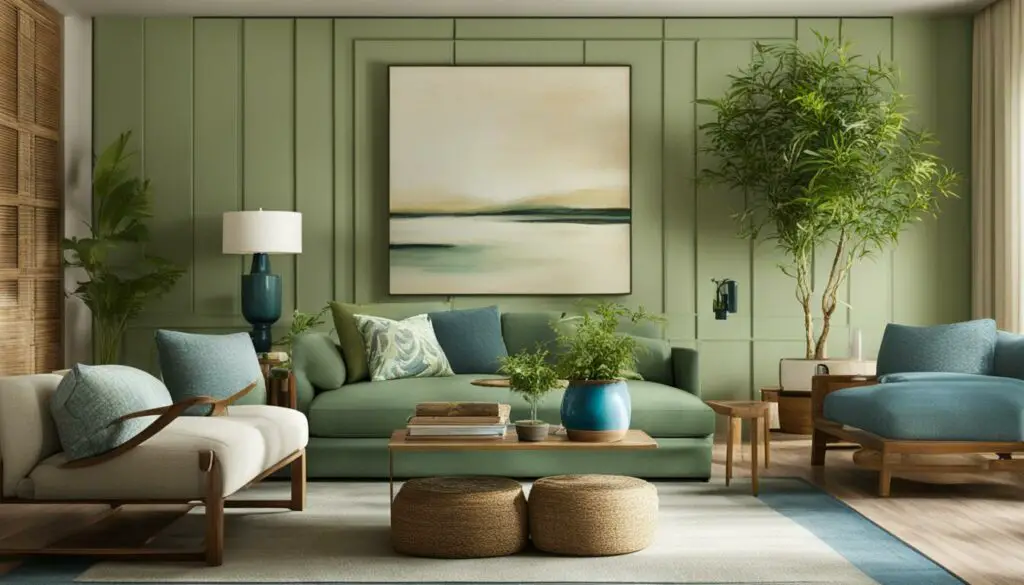
Soft Blue
“Light blue is a tranquil color, reflective of the soothing qualities of water and the sky.”
Green
“Green represents nature and growth, and it can create a harmonious and balanced atmosphere in your living room.”
Gray
“Gray is a neutral color that can promote a sense of calmness and balance, creating a soothing atmosphere in your living room.”
Beige
“Beige is a warm and inviting color that can create a cozy and comfortable living room space.”
Choosing the best Feng Shui colors for your living room can significantly impact the energy and ambiance of your space. Whether you prefer a calm and serene atmosphere or a lively and dynamic space, incorporating these Feng Shui colors can help promote positive energy and good vibes in your living room, creating a comfortable and inviting environment.
Energizing Your Living Room with Vibrant Colors
If you want to infuse your living room with energy and vitality, incorporating vibrant colors is an excellent way to achieve this. By selecting the best Feng Shui colors for your space, you can create a lively and stimulating atmosphere that encourages positivity and good vibes.
One of the best ways to energize your living room is by using shades of red. This powerful color is associated with the Fire element in Feng Shui and can create a sense of passion and excitement in your space. However, be careful not to overuse red, as it can also be too stimulating and overwhelming if used excessively.
Another great color to incorporate into your living room is yellow. This bright and cheerful color is associated with the Earth element in Feng Shui and can promote feelings of happiness and joy. However, be mindful of using too much yellow, as it can also create feelings of anxiety and restlessness if overused.
Orange is another energetic and vibrant color that can bring life to your living room. This color is associated with the Fire element and can create a sense of warmth and enthusiasm in your space. To balance the intensity of orange, pair it with softer colors like beige or white.
Finally, if you want to add a pop of color to your living room, consider using a bold and bright accent color like turquoise or hot pink. These colors can be used sparingly to create visual interest and excitement in your space.
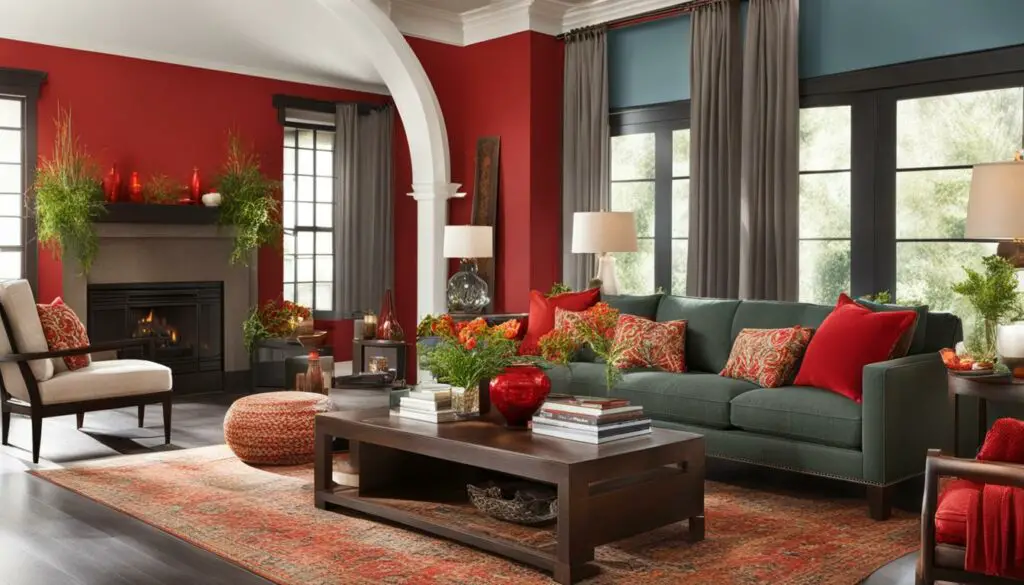
Creating Balance with Vibrant Colors
When using vibrant colors in your living room, it’s crucial to create balance to prevent the space from feeling too overwhelming or chaotic. One way to achieve balance is by using neutral colors like beige, white, or gray to anchor the bright and bold colors. Another way is by using these colors in moderation and pairing them with complementary colors to create a harmonious color scheme.
The Bottom Line
Using vibrant colors in your living room can be a great way to create a lively and energetic atmosphere that encourages positivity and good energy flow. Whether you choose red, yellow, orange, or a bold accent color, be sure to create a balance with neutral colors and complementary shades to achieve the ultimate Feng Shui balance in your space.
The Influence of Natural Elements in Feng Shui
Integrating natural elements is an essential aspect of Feng Shui decorating, as it can help promote harmony and balance in your living room.
When selecting Feng Shui colors for your living room, consider incorporating natural elements such as plants, natural textures, and organic materials. These elements can complement the chosen colors and contribute to a harmonious and balanced energy flow.
For instance, plants can bring life and vitality to your living room while also purifying the air and creating a calming atmosphere. Natural textures such as wood and stone can add warmth and grounding energy to space. Organic materials like cotton or linen can provide balance and harmony to the overall decor.
When using natural elements in your living room design, aim for a balanced distribution throughout the space. Avoid cluttering the room with too many plants or decor items, as this can create a chaotic and cluttered energy flow.

A balanced and harmonious living room can greatly enhance the positive energy flow in your space and create an inviting and welcoming atmosphere.
Accent Colors and Feng Shui
Accent colors play a crucial role in creating an optimal Feng Shui living room. These colors can highlight specific areas in your space and balance the energy flow. When choosing accent colors, consider the main Feng Shui colors in your living room color scheme. The accent colors should complement and enhance the main colors, creating a harmonious visual balance.
For example, if your main living room color scheme is based on the Wood element, with shades of green and brown, you can add accents of the Fire element, such as red or orange, to stimulate creativity and passion. Alternatively, you can incorporate accents of the Water element, with shades of blue, to create a more calming and peaceful atmosphere.
When using accent colors, it’s essential not to overdo it. Too many accent colors can create a cluttered and chaotic environment, disrupting the flow of positive energy in your living room. Stick to one or two accent colors at most, and use them sparingly throughout your living room.
The Do’s and Don’ts of Using Accent Colors in Feng Shui
Do:
- Choose accent colors that complement and enhance the main Feng Shui colors in your living room
- Use accent colors sparingly, in small doses, to create a harmonious visual balance
- Consider the energy flow and mood you want to create when selecting accent colors
Don’t:
- Use too many accent colors, which can create a cluttered and chaotic environment
- Choose accent colors that clash or create a jarring contrast with the main Feng Shui colors in your living room
- Use accent colors solely for aesthetic purposes, without considering their impact on the energy flow

Incorporating Yin and Yang Energies in Your Living Room
Yin and Yang represent the balance between feminine and masculine energies in Feng Shui. Incorporating these energies through color choices in your living room can help create a harmonious and balanced atmosphere in your space.
When selecting Feng Shui living room colors, keep in mind that Yin colors are calming and soothing, while Yang colors are energizing and stimulating. Balancing both Yin and Yang energies is essential for creating positive energy in your home.
Some popular Yin colors for the living room include:
- Blue: Promotes relaxation and tranquility, perfect for creating a serene living room atmosphere.
- Green: Symbolizes growth and renewal, bringing a sense of balance and harmony to your space.
- Purple: Associated with spirituality and enlightenment, creating a calming and peaceful energy in your living room.
On the other hand, some popular Yang colors for the living room include:
- Red: Stimulates energy and passion, perfect for creating a lively and energetic living room atmosphere.
- Orange: Represents creativity and enthusiasm, infusing your space with warmth and vitality.
- Yellow: Symbolizes happiness and optimism, bringing a bright and cheerful energy to your living room.
When selecting colors for your space, try to strike a balance between Yin and Yang energies. For example, consider using a combination of blue and orange for a balanced and harmonious color scheme.
Other ways to incorporate Yin and Yang energies in your living room include:
- Integrating soft, flowing lines (Yin) and sharp, angular shapes (Yang) in your furniture and decor
- Adding natural elements such as plants (Yin) and stones (Yang) to create a harmonious balance between the two energies.
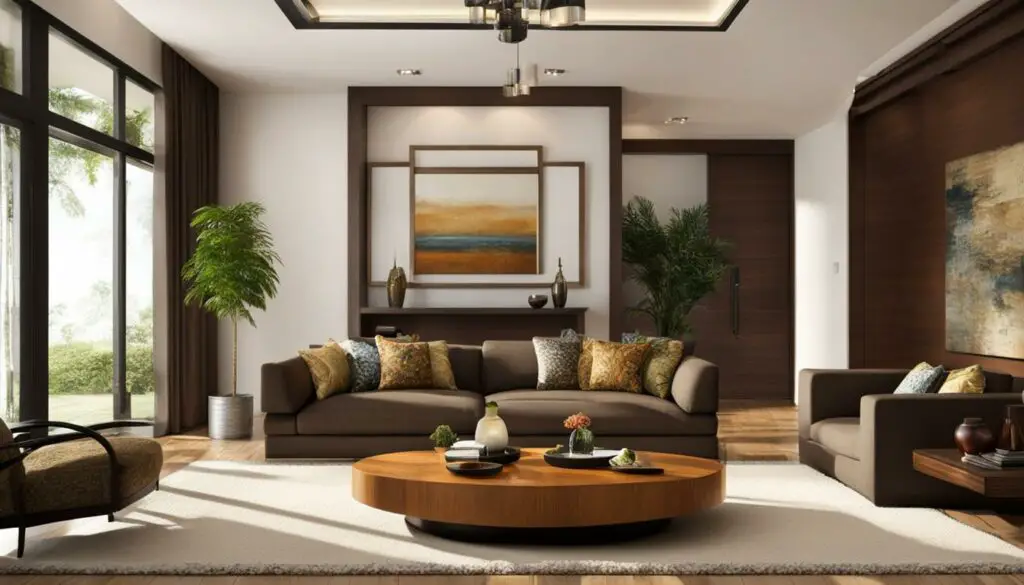
Color Placement and Feng Shui Tips
Proper color placement can make a significant difference in creating a positive energy flow in your living room. Here are some Feng Shui tips to help you maximize the benefits of your chosen colors:
Avoid Dark Colors on Ceilings
Dark colors on ceilings can create a sense of oppression and weigh down the energy in your living room. Instead, opt for light, bright colors or simple white ceilings to create a sense of spaciousness and openness.
Balance Warm and Cool Colors
Too much of any one color or temperature can create an imbalance in your living room. To create harmony and balance, try to balance warm and cool colors. For example, if you have a warm red sofa, balance it out with cool blue accents.
| Warm Colors | Cool Colors |
|---|---|
| Red | Blue |
| Orange | Green |
| Yellow | Purple |
Use the Bagua Map
The Bagua Map is a tool used in Feng Shui to help you identify the different areas of your living room and their corresponding colors. By aligning your colors with the Bagua Map, you can create a more harmonious and balanced living environment.

Use Natural Light
Natural light is an excellent source of positive energy in your living room. Make sure to allow plenty of natural light in by keeping windows unobstructed and using sheer curtains or shades. If natural light is limited, you can use artificial light, but make sure to choose warm, soft lighting that mimics the glow of natural light.
Declutter Your Living Room
Clutter can disrupt the flow of energy in your living room and create negative energy. Keep your living room clean and clutter-free by regularly decluttering and organizing your space.
Use Plants and Natural Elements
Plants and natural elements like stones and wood can enhance the positive energy in your living room. Use plants to purify the air and add life to your space, and incorporate natural textures and materials into your decor.
By following these Feng Shui tips, you can create a harmonious and positive energy flow in your living room. Experiment with different color placements and natural elements to find the perfect balance for your space.
Conclusion
Choosing the right Feng Shui colors for your living room is a powerful way to promote positive energy, harmony, and balance in your space. By understanding the basics of Feng Shui principles and color psychology, you can create a color scheme and decor that aligns with your personal preferences and promotes a peaceful, relaxing atmosphere.
Remember to harmonize your colors, integrate natural elements, and incorporate accent colors that complement your main Feng Shui colors. Consider the placement of furniture and decor items to maximize the flow of positive energy in your living room. Strive to create a harmonious balance between Yin and Yang energies and experiment with different colors to find the perfect Feng Shui balance for your space.
With these tips and guidelines, you can enhance the energy and ambiance of your living room significantly. So why not start thinking about the best Feng Shui colors for your living room today and create a space that reflects balance, harmony, and tranquility.
FAQ
What are the best Feng Shui colors for my living room?
The best Feng Shui colors for your living room depend on the energy you want to create. For a calm and serene atmosphere, consider soft blues and soothing neutrals. If you prefer a vibrant and energetic space, vibrant colors like bold reds and vibrant yellows can work well. It’s important to choose colors that align with your desired mood and enhance the harmony in your living room.
How can Feng Shui colors enhance harmony in my living room?
Feng Shui colors can enhance harmony in your living room by creating a balanced and harmonious energy flow. Each color has its own energetic properties, and when used strategically, they can promote a sense of tranquility and balance. By choosing colors that support the specific energy you want to cultivate, you can create a living room that feels harmonious and inviting.
How do I create a harmonious color scheme in my living room?
To create a harmonious color scheme in your living room, consider the principles of Feng Shui as well as your personal preferences. Start by selecting a main color that aligns with the energy you want to create. Then, choose complementary colors that enhance and balance that main color. It’s essential to create a visual flow and avoid overwhelming the space with too many different colors. Experiment with different combinations and trust your intuition to find the perfect balance.
What are the five elements in Feng Shui and their associated colors?
The five elements in Feng Shui are Wood, Fire, Earth, Metal, and Water. Each element has its own associated colors that can enhance different aspects of energy in your living room. Wood is associated with green and brown, Fire with red and orange, Earth with yellow and beige, Metal with white and gray, and Water with blue and black. By incorporating these colors strategically, you can create a harmonious balance of elemental energies in your living room.
How do accent colors contribute to Feng Shui in the living room?
Accent colors play a significant role in Feng Shui as they can highlight specific areas and enhance the overall energy flow in your living room. When choosing accent colors, consider the main Feng Shui colors in your space and select complementary shades that add visual interest and balance. Accent colors can be incorporated through pillows, artwork, rugs, or small decor items. They help create a harmonious visual balance and draw attention to key elements in your living room.
How can I incorporate Yin and Yang energies through color choices in my living room?
Yin and Yang energies represent the balance between feminine and masculine energies in Feng Shui. To incorporate Yin energy, consider using lighter and softer colors like pastels or cool tones. For Yang energy, opt for bolder and more vibrant colors like red or strong earth tones. Balancing these energies through color choices can create a harmonious and balanced atmosphere in your living room.
What are some practical color placement and Feng Shui tips for my living room?
When it comes to color placement and Feng Shui, consider the Bagua map, which divides your living room into nine areas representing different aspects of life. Use colors that correspond to each area to enhance the energy flow. Additionally, arrange furniture and decor items in a way that allows for easy movement and promotes a sense of balance. Ensure that colors are evenly distributed throughout the room and avoid clutter that can disrupt the flow of energy.
